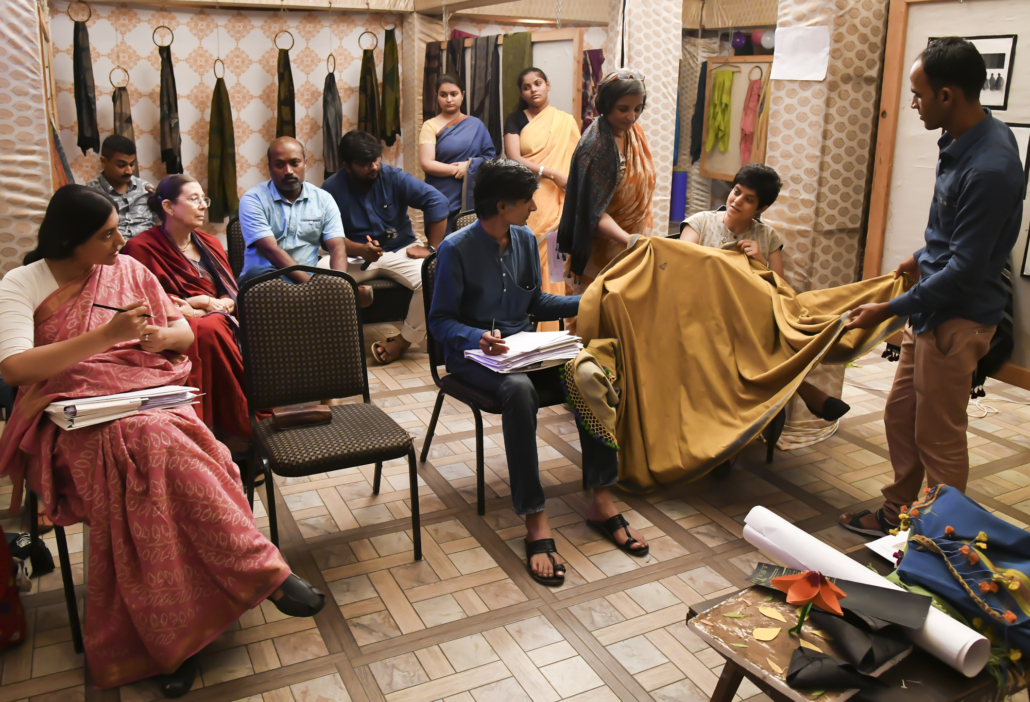Market Forces
As I edit images from this year’s juries, I can’t help but notice that several of our artisan design students who gained remarkable confidence over the year hardly met the eyes of the jury members. It sobers me and makes me sad, and I wish we could have held the jury seminar that we had planned. This year’s topic was “Market Forces.” The essential discussion with the artisan design community is postponed, but for now, here are my thoughts and questions on the matter.

Today’s craft is created for urban markets. Somaiya Kala Vidya’s design education program teaches artisans to make theme-based, market-oriented collections. Students work very hard to create unique, new looks. Yet, when it’s time to go to an exhibition in Delhi, Mumbai, Bangalore, the collection is left behind and artisans bring “regular” work (what is already in the market, sometimes for many years). Even for the final show, organized by the institute specifically to launch the new collections, students hesitate and want to bring along “regular” designs.
What is it about “The Market” that makes artisans hesitate? What is it that makes them want to lower their gaze? Once again, we come face to face with the demon of power differential.
The demon is the mutually perceived hierarchy between rural and urban, poor and rich, less educated/ provincial and more educated/ worldly. The demon is the unknown. For students who have had little exposure to the market it is understandable that they hesitate to present work that is new. What if people don’t like it?
Traditionally, artisans in Kutch created for families that were hereditarily linked to them, for communities that they intimately knew. There was no guess work. As those communities slowly evolved, artisans effortlessly, organically created what they wanted.
I have taken artisans to the USA for events and again and again seen them completely balk at food they have never seen. They want the roti-vegetable-rice-dal that they already know. This is their world. They have experienced no margin of variation from which to want to experiment. So they would imagine their customers to behave in the same way.
I too once thought that “The Market” was the contemporary counterpart to traditional clients. But the dynamic is very different- even diametrically opposed. The traditional client and artisan shared standards of evaluation, and in the best scenarios mutual recognition and respect. The artisan made the best possible, as he knew it would be appreciated. The market wants something trendy, at the lowest common denominator- cheap, fast, standard. The industrial model.
Urban customers are abstract. How can one imagine what one has not experienced? In our education program we try to close the gap with an exposure to the Ahmedabad market in our Market Orientation course. But exposure and experience are different.
So what about artisan design graduates who have experience? I asked a team who has sold their work in exhibitions why they thought that artisan designers hesitated to sell their new designs? “In our experience,” they answered, “The Market wants traditional work. No matter what we bring, they ask for red and black.”
Which market?
“Mumbai, Delhi.”
But which market in these cities? Is there really one “Market?” Have we restricted ourselves to places where craft is usually sold, and in which expectations are limited?
When we began Kala Raksha in 1993, my colleague Prakashbhai observed that bazaars held outdoors in tents were for cheaper goods than those held inside buildings. When Dilli Haat held its first exhibition in tents on its planned site, I talked with a weaver of heavy gold brocade Paithani saris. His saris were not selling. “This is not the right market for me,” he laughed. He packed up his work, took it into town, and sold it at appropriate shops.
It is important to calculate where to sell what.
And do we consider “The Market” as dynamic? As we observe sales (per artisan) slipping in the International Folk Art Market| Santa Fe, my friend notes that as the product mix shifts to more contemporary casual work, the people who come to buy at this market will also change.
When will our soon-to-graduate artisan students feel more worthy? When will they think beyond offering what is already in the market?
Ownership as well as experience is central to growth and sustainability. Artisans need to ask these questions and experiment. The method is try, analyze feedback, try again. It requires capital as well as ownership.
I once asked very well-established senior artisans to what they attributed their success? Alimamad Isha responded that his success developed from direct contact with customers- and listening, watching what they like. He gathered their sensibilities and translated them into his work. He innovated, was sought out, and the cycle gained its own momentum.
Our graduates with a lot of experience and success can tell you what is likely to sell in Mumbai, Delhi, Kolkata and Bangalore- and in which venues and which seasons. This builds their confidence to experiment and innovate. It enables calculated risks.
So does the market force artisans? Or do they limit themselves by imagining it to? Who can force the market? Who can introduce trends?
We have a few examples of long successful innovations: The bandhani and Ajrakh print sari introduced by a graduate in 2008 and still selling well. New Ajrakh patterns inspired by Taj Mahel jalis, also introduced by a graduate and now adopted by the entire community as a “new tradition.”
Living traditions always evolve, but this can only happen when artisans have direct contact with consumers. It has to be a dynamic situation. One thing is for sure, as long as people and organizations wanting to “help” intervene, they prevent artisans from coming to terms with “The Market.” The status quo of artisans cowed by market forces does not justify giving them designs and selling their work for one’s own benefit. Confidence comes with experiencing success far more than with filling someone’s order as a worker. Our job as intermediaries is to facilitate the connection to good markets and then let artisans make decisions and take responsibility for what to make and where to sell it.
Only then will craft traditions and cultural heritage be sustained



